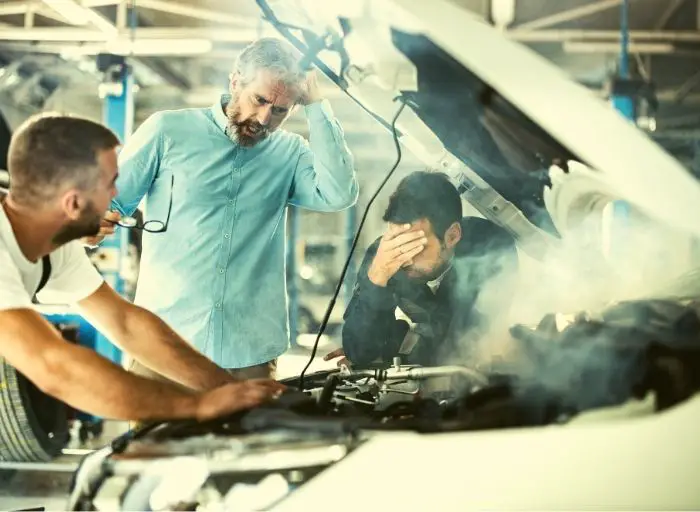
Wondering about overheating car fix? Modern vehicles use intricate cooling systems to keep your engine running in any weather condition. However, overheating can still occur. If your engine overheats, you’ll need to know what to do to avoid permanent damage.
Table of Contents
What Causes Engines to Heat Up?
Many factors can cause engines to overheat. In general, this is due to a problem with the cooling system, which prevents heat from escaping the engine compartment. A cooling system leak, a damaged radiator fan, a broken water pump, or a clogged coolant hose could be the root of the problem.
An overheating engine, regardless of its cause, isn’t something you want to ignore. Your engine may suffer substantial, if not irreversible, damage.
When a Car Engine Overheats, What Happens?
The following are common warning signals of an overheated automotive engine:
1. The scorching hot hood
The hood of a running automobile heats up, and you can safely contact it to experience its warmth. When your car’s engine overheats, the hood gets incredibly hot, to the point where keeping your palm on it for more than a few seconds is dangerous owing to the risk of burns.
2. The temperature light on the dashboard
When your vehicle’s engine generates excessive levels of heat, a temperature light on the dashboard flashes. This indicator can help you see an overheating motor, but it isn’t 100% accurate. The light may not be able to identify whether your car’s engine is overheating due to a coolant leak because it is triggered depending on the temperature of the coolant in your engine’s cooling system.
3. Ticking sound
The sound of a ticking engine is something that no automobile owner wants to hear. This noise usually means your car’s engine oil can’t lubricate various engine components adequately. When your car runs at high temperatures, the ticking sound means your engine parts are clacking against each other loudly, causing significant wear and tear.
4. Coolant leaking
A pool of coolant beneath your vehicle indicates that it is leaking coolant. It could also indicate that your car’s engine is overheating, causing coolant in the radiator to boil.
5. Steam coming out of the hood
The presence of steam beneath your car’s hood indicates that the coolant in your vehicle has exceeded its boiling point. The coolant will turn from liquid to steam at this point, and steam will billow from the front and sides of the hood.
Overheating Car Fix: 5 Simple Steps
When your engine overheats, follow these five steps:
1. Switch on the heat
It’s advisable to turn on the heating, which may seem illogical. The heat will be transferred from the engine to the passenger compartment, making the engine’s cooling system less taxed. In some cases, that may be enough to stop the overheating. If the warning light goes out or the temp gauge goes back to the neutral position, you know it’s working
2. Pullover
If your car remains to overheat after a few minutes of driving with the heater on, pull over and turn off the engine. It’s the safest and most effective approach to cool the engine. It’s recommended that if you have roadside help, now is a good time to call because you might require a tow.
3. No rush
If you don’t have access to roadside help, be patient; cooling the engine will take roughly 15 minutes. Meanwhile, don’t start to access the hood; the coolant in an overheated automobile could reach above 230 degrees. There’s a chance of being blasted with hot steam if the hood is opened.
4. Pour in the coolant
Open the hood, and identify the radiator cap (check the owner’s manual if necessary), after having waited 15 minutes and the hood is cool to the touch. Cover the cap with a towel and gently loosen it a quarter turn to relieve the pressure that has built up due to the coolant swelling when heated. Then, with the radiator cap fully open, slowly pour in coolant until the liquid level reaches the “full” line.
5. Make your way to a service station
Adding coolant won’t fix the problem that led to overheating in the first place, but it will usually get you to the nearest repair shop safely.
When Your Engine Overheats, Don’t Do These Things
1. Don’t freak out
Your engine isn’t keeping up with the rest of the world, but you can! When getting off the road, avoid swerving through traffic or hitting the brakes.
2. Do not continue to drive
If your engine is overheated but still running, being on the road isn’t doing it any favors. Sure, you might make it to your destination before it completely dies, but pushing your engine too hard could result in serious (and costly) damage.
3. Do not immediately open the hood
After you’ve pulled over, let the engine cool down before peeking under the hood to see what’s going on. Immediately opening the hood exposes you to the possibility of burns or injuries caused by steam or smoke. Patience is essential. Before opening the hood, wait until the engine thermostat has stabilized.
How Do I Prevent My Car Engine From Becoming Overheated?
If you look after your car, it will look after you. Frequent coolant flushes and exchanges, as well as keeping up with radiator maintenance as required by your vehicle manufacturer, are the greatest ways to avoid an overheating car engine. Routine checkups can also help you identify and address any possible radiator or engine problems before they become more serious.
Conclusion
The easiest strategy to keep your car engine from overheating is to maintain it on a regular basis. Coolant flushes and radiator maintenance can help to reduce the chance of your engine overheating.
Hi there! I’m Naomi O’Colman. I’ve got years of experience working at an auto repair shop here in Texas under my belt. On top of that, ever since I was a kid I’ve been passionate about the auto industry. Since I’ve joined the team at automotivegearz.com I’ve been enthusiastically sharing my passion and insights with my readers. I’m dedicated to delivering high quality content and helping you stay up to date with the latest automotive trends and products out there!







